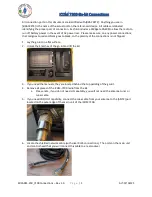
PAMS Technical Documentation
System Module
NSB-5
Issue 1 03/01
Nokia Mobile Phones Ltd.
Page 25
Startup Charging
When a charger is connected, the CHAPS is supplying a startup current minimum of
130mA to the phone. The startup current provides initial charging to a phone with an
empty battery. Startup circuit charges the battery until the battery voltage level reaches
3.0V (+/– 0.1V) and the CCONT releases the PURX reset signal and program execution
starts. Charging mode is changed from startup charging to PWM charging that is con-
trolled by the MCU software. If the battery voltage reaches 3.55V (3.75V maximum)
before the program has taken control over the charging, the startup current is switched
off. The startup current is switched on again when the battery voltage is sunken
100mV (nominal).
Battery Overvoltage Protection
Output overvoltage protection is used to protect phone from damage. This function is
also used to define the protection cutoff voltage for different battery types (Li or Ni). The
power switch is immediately turned OFF if the voltage in VOUT rises above the selected
limit VLIM1 or VLIM2.
Table 7: Battery Overvoltage Protection
The voltage limit (VLIM1 or VLIM2) is selected by logic LOW or logic HIGH on the CHAPS
(N101) LIM– input pin. Default value is lower limit VLIM1.
Table 6: Startup Charging Parameters
Parameter
Symbol
Min
Typ
Max
Unit
VOUT start-up mode cutoff limit
Vstart
3.45
3.55
3.75
V
VOUT start-up mode hysteresis
Note: COUT = 4.7
µ
F
Vstarthys
80
100
200
mV
Start-up regulator output current
VOUT = 0V ... Vstart
Istart
130
165
200
mA
Parameter
Symbol
LIM
input
Min
Typ
Max
Unit
Output voltage cutoff limit (during
transmission or Li-battery)
VLIM1
LOW
4.4
4.6
4.8
V
Output voltage cutoff limit (no
transmission or Ni-battery)F
VLIM2
HIGH
4.8
5.0
5.2
V
















































